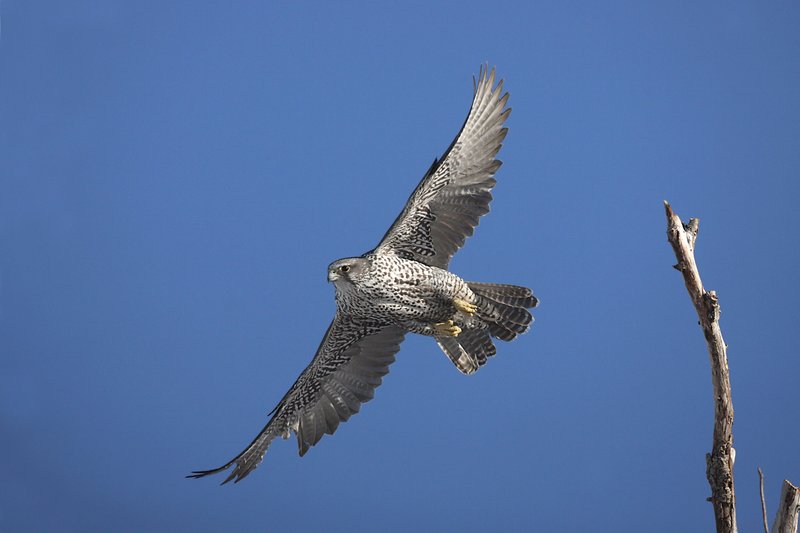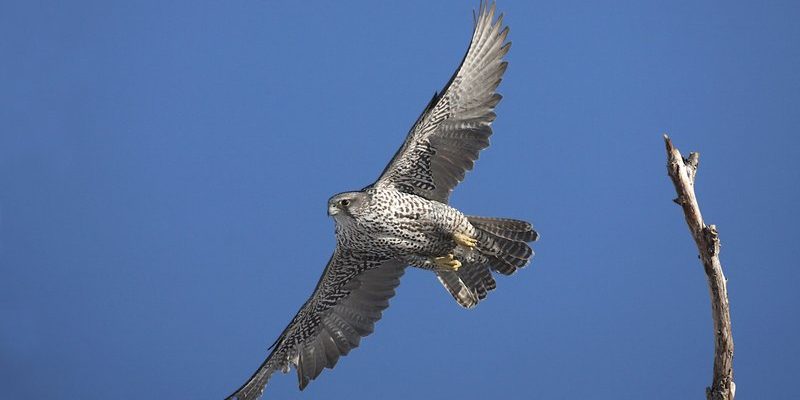
Gyrfalcons, with their striking plumage and powerful wings, are the largest falcons in the world. You might picture them soaring high above desolate tundras, scanning the landscape for food. But their success goes far beyond mere flying skills. Their ability to adapt to their surroundings is nothing short of remarkable. Let’s explore how these birds not only survive but thrive in some of the planet’s most unforgiving habitats.
Physical Adaptations for Cold Climates
Gyrfalcons are built for survival in the cold. Their bodies are covered in dense feathers that provide crucial insulation against the frigid Arctic temperatures. This feathering is not just for show; it helps trap heat close to their bodies. You can think of it like wearing a super warm down jacket—it keeps them cozy even when the mercury drops.
Their larger size compared to other falcons is also a significant advantage. With a wingspan that can reach up to 4 feet, gyrfalcons can generate more lift and glide longer distances when hunting. This size also means they have more muscle, which is vital for their survival. They can tackle larger prey, which is sometimes necessary when food is scarce.
Additionally, their sharp talons and beak are perfectly designed for tearing into their catch. They typically hunt birds like ptarmigans or even small mammals, which are essential for their diet. This ability to adapt their hunting tactics to the available prey is crucial for their success.
Behavioral Adaptations: Hunting Strategies
When it comes to hunting, gyrfalcons employ impressive strategies that reflect their adaptability. They are skilled hunters and can switch their methods based on the season and availability of food. In winter, they often rely on their strength to chase down prey. On the other hand, in the summer, they may take to high perches, scanning the ground for unsuspecting meals.
Gyrfalcons are also known for their incredible speed. They can dive at speeds over 100 miles per hour when catching prey. This speed gives them an edge, allowing them to surprise their targets effectively. You might be wondering how they manage this in the icy conditions—it’s all about practice and adaptation. Through generations, gyrfalcons have honed their hunting techniques to overcome the challenges of their environment.
Another fascinating aspect of their behavior is their territory. Gyrfalcons typically have large territories, which they patrol regularly. This strategy not only ensures they have enough food but also helps reduce competition with other birds. When resources are scarce, spreading out is a smart move.
Migration and Seasonal Adaptation
Gyrfalcons are somewhat unique in their approach to migration. While many birds flee the cold, some populations of gyrfalcons are resident birds, meaning they stay in their Arctic habitats year-round. This decision comes with its own set of challenges and adaptations.
During the harsh winter months, these falcons rely on their adaptability to find food. They’ve been known to migrate short distances to follow prey availability. This flexibility in their movements helps ensure they don’t go hungry when the environment changes.
In summer, gyrfalcons thrive on the longer days, which allow for extended hunting times. The abundance of daylight provides more opportunities to catch food, and the warmer weather makes it easier to raise their young in cliffside nests. This seasonal adaptation is vital for their life cycle.
Social Behavior and Breeding
The social structures of gyrfalcons are another area where we see adaptation. These birds typically mate for life, forming strong bonds that help them raise their young together. During the breeding season, they become fiercely protective of their territory, ensuring that they have enough resources to feed their chicks.
Nest building is a crucial part of their breeding behavior. Gyrfalcons tend to choose remote cliffs as nesting sites, providing safety from predators and human intrusion. Here’s the thing: these locations not only protect their eggs but also offer great vantage points for spotting prey. When the chicks hatch, the parents work together to provide food, showcasing their commitment to raising a family.
Moreover, during the nesting period, the parents exhibit interesting behaviors. They perform aerial displays to strengthen their pair bond and communicate effectively, ensuring they’re on the same page when it comes to hunting and protecting their young.
The Role of Camouflage in Survival
When you think of survival in the wild, camouflage often comes to mind. For gyrfalcons, their plumage color plays a vital role. Depending on the region and time of year, their feathers can range from dark gray to nearly white, allowing them to blend seamlessly into their surroundings.
This natural camouflage helps them not only as hunters but also as protectors of their nests. Young chicks, which are vulnerable to predators, benefit from their parents’ ability to remain hidden. You might find it fascinating how a bird’s coloration can significantly impact its survival odds—it’s like having the best disguise at a game of hide-and-seek.
Additionally, their perch selection is influenced by their need for camouflage. Gyrfalcons often choose high vantage points that allow them to survey their territory while remaining inconspicuous. This strategy makes them more effective hunters and protects them from potential threats.
Conservation Status and Human Impact
Unfortunately, despite their impressive adaptations, gyrfalcons face threats from human activities. Habitat destruction, climate change, and hunting can significantly impact their populations. While these birds have adapted to survive in extreme conditions, changes in their environment can challenge even the strongest of species.
Conservation efforts are crucial to ensure gyrfalcons continue to thrive. Protected areas help safeguard their habitats, while breeding programs can boost population numbers. You might wonder how you can help—supporting wildlife conservation initiatives goes a long way.
Public awareness and education also play a key role. Understanding the challenges gyrfalcons face can inspire people to take action. When communities come together to protect these magnificent birds, we can help ensure they remain a part of our planet’s ecosystem for generations to come.
Gyrfalcons are a true testament to the power of adaptation in nature. From their remarkable physical traits to their strategic hunting methods and nesting behavior, these birds have developed unique ways to thrive in harsh environments. Their ability to blend into their surroundings and adapt to seasonal changes shows just how incredible these creatures are.
As we learn more about gyrfalcons and the challenges they face, it’s essential to appreciate their beauty and resilience. By protecting their habitats and supporting conservation efforts, we can ensure that these majestic birds continue to soar through our skies. So, next time you think of falcons, remember the gyrfalcon and its extraordinary journey of adaptation.

